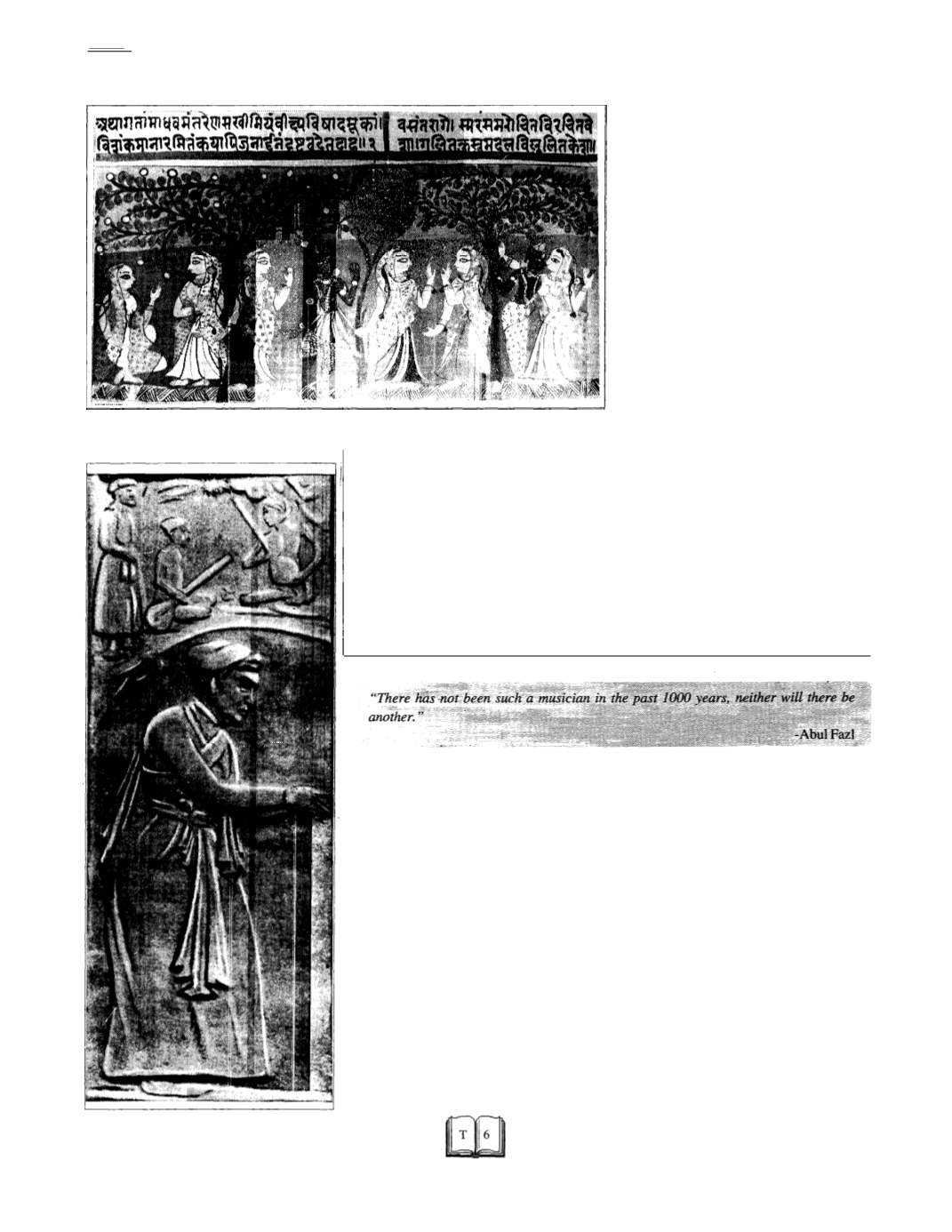

MUSIC
Eternal India
encyclopedia
JAYADEVA
TANSEN
He lived in the 12th-13thC. Not much is
known about his place of birth. He was left an
orphan even when he was a child. He did not
seem to have any worldly desires and took to
wandering like a mendicant with the name of
Hari on his lips. Eventually he reached Puri
in Orissa. Here he married Padmavathi, the
daughter of a Brahmin. The couple had an
extremely happy married life. Jayadeva was
recognised as a great poet. He was made the
court poet by Raja Lakshmana Sena (1178-
1205 A.D.) of Nabadweep, Bengal. His San-
skrit poem, Geeta Govinda is an important
landmark in the history of Indian music. Apart
from the beauty of language, it is a sublime
mystic composition.
“The sky is clouded; and the wood resembles
The sky, thick-arched with black Tamala
boughs;
O Radha, Radha! take this soul, that trembles
In life's deep midnight, to thy golden house.
So Nanda spoke-and, led by Radha's spirit
The feet of Krishna found the road aright
Wherefore, in bliss which all high hearts
inherit,
Together taste they Love's divine delight. ”
Geeta Govinda
This poetical work deals with the Radha
Krishna theme. It contains 12 chapters, com-
prising 24 ashtapadis interspersed with slokas
(verses). It depicts the separation of Radha
(devotee) from the Adored (Krishna) due to
ignorance. The guru (sakhi)‘dispels the igno-
rance of Radha, invokes the blessings of the
Lord and brings about the union of the two.
The work uses erotic symbolism, though
it is deeply moving and beautiful. There is
nothing obscene or vulgar. The mutual love
of Radha and Krishna is intense but delicate -
- madhura bhakti, the essence of Vaishnavite
adoration. This work is used as a theme in
many important Indian dances — Odissi,
Kuchipudi, Bharatanatyam, Kathakali etc.
His father was a Hindu priest living in a
village close to Gwalior. He was born in
1492 after his father had sought the blessings
of a famous Muslim saint of Gwalior, Mo-
hammad Ghouse. He was named Ramtanu.
He was also called Tanna Misra, later known
to the world as Tansen.
According to tradition he was a disciple
of Swami Haridas of Brindavan. According
to other sources Ramtanu's early musical
education was under Raja Man Singh of
Gwalior. He is also believed to have gone to
Bengal to study music under Mohammad
Shah Adil, the last king of the Suri dynasty.
Later he returned to Rewa to become the
court musician of Raja Ramachandra.
It is believed that Ramtanu (Tanna
Misra) became a Muslim in order to marry a
girl of that religion. From then on he came to
be called Ata Ali Khan.
' His greatness as a singer was recognised
early and he was conferred the honorific title
"Tansen" by Raja Vikramjit, the ruler of
Gwalior. He later came under the patronage
of Raja Ramachandra Baghela of Rewa. The
Moghul emperor Akbar hearing about the
musical genius of Tansen, asked Raja Rama-
chandra Baghela to surrender Tansen to him.
Tansen entered the sevices of Emperor Akbar
in 1562 A.D. and became famous as one of the
"nine gems" of the Moghul court.
He is credited with thousands of
dhru-
pads.
Three works -
Sangat Sar, Rag Mala
and
Sri Ganesa Stotra
— are attributed to him.
He is traditionally accepted as the creator of
new ragas which bear the prefix
Miyan :
Miyanki Todi, Miyanki Sarana, Miyanki Mal-
har
etc. Raga Darbari Kanada is his contribu-
tion to the music of North India. Tansen died
in 1595 at Gwalior.
















